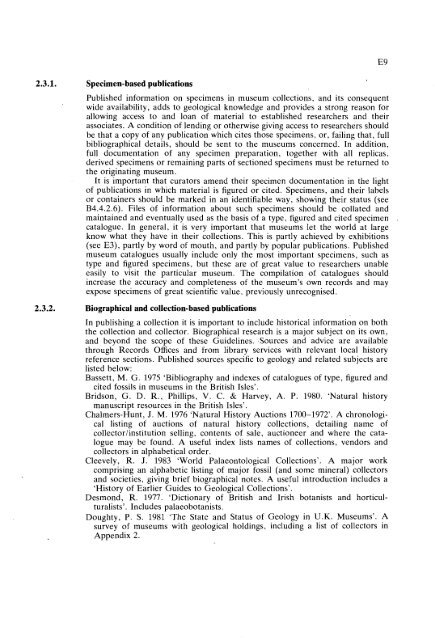GUIDELINES FOR THE CURATION OF GEOLOGICAL MATERIALS
GUIDELINES FOR THE CURATION OF GEOLOGICAL MATERIALS
GUIDELINES FOR THE CURATION OF GEOLOGICAL MATERIALS
You also want an ePaper? Increase the reach of your titles
YUMPU automatically turns print PDFs into web optimized ePapers that Google loves.
Specimen-based publications<br />
Published information on specimens in museum collections, and its consequent<br />
wide availability, adds to geological knowledge and provides a strong reason for<br />
allowing access to and loan of material to established researchers and their<br />
associates. A condition of lending or otherwise giving access to researchers should<br />
be that a copy of any publication which cites those specimens, or, failing that, full<br />
bibliographical details, should be sent to the museums concerned. In addition,<br />
full documentation of any specimen preparation, together with all replicas,<br />
derived specimens or remaining parts of sectioned specimens must be returned to<br />
the originating museum.<br />
It is important that curators amend their specimen documentation in the light<br />
of publications in which material is figured or cited. Specimens, and their labels<br />
or containers should be marked in an identifiable way, showing their status (see<br />
B4.4.2.6). Files of information about such specimens should be collated and<br />
maintained and eventually used as the basis of a type, figured and cited specimen .<br />
catalogue. In general, it is very important that museums let the world at large<br />
know what they have in their collections. This is partly achieved by exhibitions<br />
(see E3), partly by word of mouth, and partly by popular publications. Published<br />
museum catalogues usually include only the most important specimens, such as<br />
type and figured specimens, but these are of great value to researchers unable<br />
easily to visit the particular museum. The compilation of catalogues should<br />
increase the accuracy and completeness of the museum's own records and may<br />
expose specimens of great scientific value, previously unrecognised.<br />
Biographical and collection-based publications<br />
In publishing a collection it is important to include historical information on both<br />
the collection and collector. Biographical research is a major subject on its own,<br />
and beyond the scope of these Guidelines. ,Sources and advice are available<br />
through Records Offices and from library services with relevant local history<br />
reference sections. Published sources specific to geology and related subjects are<br />
listed below:<br />
Bassett, M. G. 1975 'Bibliography and indexes of catalogues of type, figured and<br />
cited fossils in museums in the British Isles'.<br />
Bridson, G. D. R., Phillips, V. C. & Harvey, A. P. 1980. 'Natural history<br />
manuscript resources in the British Isles'.<br />
Chalmers-Hunt, J. M. 1976 'Natural History Auctions 1700-1972'. A chronological<br />
listing of auctions of natural history collections, detailing name of<br />
collectoriinstitution selling, contents of sale, auctioneer and where the catalogue<br />
may be found. A useful index lists names of collections, vendors and<br />
collectors in alphabetical order.<br />
Cleevely, R. J. 1983 'World Palaeontological Collections'. A major work<br />
comprising an alphabetic listing of major fossil (and some mineral) collectors<br />
and societies, giving brief biographical notes. A useful introduction includes a<br />
'History of Earlier Guides to Geological Collections'.<br />
Desmond, R. 1977. 'Dictionary of British and Irish botanists and horticulturalists'.<br />
Includes palaeobotanists.<br />
Doughty, P. S. 1981 'The State and Status of Geology in U.K. Museums'. A<br />
survey of museums with geological holdings, including a list of collectors in<br />
Appendix 2.

















